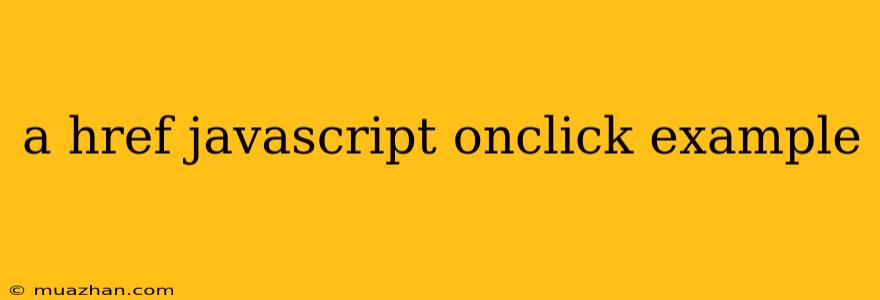A Href JavaScript Onclick Example: Combining Navigation and Functionality
The href attribute in an anchor tag (<a>) is typically used to link to another webpage or resource. However, it can also be used to execute JavaScript code when the link is clicked. This is achieved by setting the href attribute to "javascript:" and then including the JavaScript code within the onclick attribute.
Here's a breakdown of how this works, along with some common use cases and examples:
Basic Example
Let's start with a simple example of a link that will display an alert box when clicked:
Click me!
In this example:
href="javascript:void(0)": This prevents the browser from navigating to a specific URL. Thevoid(0)function returns nothing, effectively stopping the default action of the link.onclick="alert('Hello, world!');": This executes the JavaScript codealert('Hello, world!');when the link is clicked, which displays an alert box with the message "Hello, world!".
Preventing Default Behavior
Another common use case for href="javascript:void(0)" is to prevent the default behavior of a link. This is particularly useful for links that don't need to navigate to another page but still need to trigger some JavaScript functionality.
For instance, consider a link that should trigger a function to open a modal dialog:
Open Modal
In this case, the onclick attribute calls the openModal() function. The href="javascript:void(0)" prevents the link from navigating to a blank page, ensuring only the modal dialog is opened.
Using this Keyword
The this keyword within the onclick attribute refers to the clicked element, allowing you to access its properties or manipulate its behavior.
Here's an example that changes the background color of the clicked link to blue:
Click to change color
When the link is clicked, the onclick attribute sets the background color of the link (this) to blue.
Advantages of Using href="javascript:void(0)":
- Simple and concise: It's a straightforward way to trigger JavaScript functionality on link clicks.
- Clear intention: Explicitly stating
href="javascript:void(0)"makes it clear that the link doesn't intend to navigate to another page. - Accessibility: When used responsibly, it can enhance accessibility by providing clear visual cues and alternative ways to interact with the content.
Considerations:
- Accessibility: While
href="javascript:void(0)"can be useful, ensure that alternative ways to access the functionality are available for users who might not rely on clicking links (e.g., using keyboard navigation or screen readers). - Complex logic: For more complex JavaScript logic, consider using event listeners and separating the logic from the HTML markup for better maintainability and organization.
In conclusion, using href="javascript:void(0)" in conjunction with the onclick attribute provides a simple and effective way to combine navigation and functionality within an anchor tag. By carefully considering the implications and alternatives, you can leverage this technique to enhance the interactivity and user experience of your webpages.
